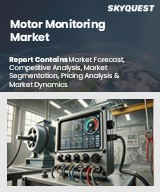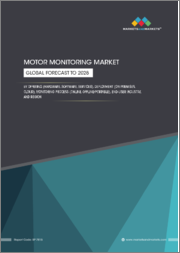
|
시장보고서
상품코드
1541351
모터 모니터링 시장 보고서 : 제공, 모니터링 프로세스, 최종 용도, 지역별(2024-2032년)Motor Monitoring Market Report by Offering, Monitoring Process, End Use, and Region 2024-2032 |
||||||
세계 모터 모니터링 시장 규모는 2023년 24억 달러에 달했습니다. 향후 IMARC Group은 2032년까지 시장 규모가 43억 달러에 달하고 2024-2032년 연평균 성장률(CAGR)이 6.5%에 달할 것으로 예측했습니다.
모터 모니터링은 최신 첨단 장비를 이용한 철저한 테스트가 수반되는 예지보전 중 하나입니다. 모터의 성능을 추적하고 수리에 필요한 가동 중지 시간을 최소화하는 데 중점을 둡니다. 시동 부하, 주변 온도, 테스트 용이성, 예비 부품의 가용성, 시동 및 정지 횟수를 분석합니다. 잠재적인 문제를 발견하고 계획되지 않은 심각한 다운 타임을 피하고 효율성을 보장하며 플랜트 운영을 개선하는 데 도움이됩니다. 그 결과 전 세계 자동차 산업, 항공우주 산업, 석유 및 가스 산업에서 널리 사용되고 있습니다. 현재 여러 기업이 온라인 플랫폼을 통해 모터 모니터링 서비스를 제공하고 있으며, 전력 품질 및 작동 상태에 대한 자세한 정보를 제공하고 있습니다.
모터 모니터링 시장 동향
전기 모터는 내구성과 효율성이 뛰어나고, 유지보수가 필요 없으며, 에너지 소비가 적고, 변동 전압에 대한 내구성이 높습니다. 이는 가전제품, 공작기계, 산업용 팬 등 다양한 응용 분야와 함께 시장 성장을 촉진하는 주요 요인 중 하나입니다. 또한, 많은 국가의 정부 기관은 에너지 효율이 높은 제품의 채택을 촉진하고 다양한 산업 부문에서 이산화탄소 배출을 줄이기 위해 엄격한 정책을 수립하고 있습니다. 이는 화석 연료 엔진보다 친환경적이고 저렴한 모터에 대한 수요에 긍정적인 영향을 미치고 있습니다. 기계가 고장나기 전에 잠재적인 문제를 감지하는 것이 점점 더 중요해지면서 시장 성장을 촉진하고 있습니다. 이와는 별도로, 시장의 주요 기업들은 3개의 전압 프로브와 해당 전류 변압기를 통해 데이터를 수집하는 첨단 테스트 장비를 도입하고 있습니다. 데이터는 중단 없는 비교, 보고 및 추세를 위해 기록, 계산 및 해석할 수 있습니다. 이러한 기술 혁신은 시장에 밝은 전망을 가져다주고 있습니다. 또한, 스포츠 및 열화상 분야에서 모터 모니터링의 사용 증가와 같은 요인이 시장을 주도할 것으로 예상됩니다.
본 보고서에서 다루는 주요 질문들
- 모터 모니터링 시장 세계 시장 규모는?
- 2024-2032년 세계 모터 모니터링 시장의 예상 성장률은?
- 세계 모터 모니터링 시장을 이끄는 주요 요인은 무엇인가?
- COVID-19가 세계 모터 모니터링 시장에 미치는 영향은?
- 모터 모니터링 시장 세계 시장 내 제품별 분석은 어떻게 되는가?
- 세계 모터 모니터링 시장의 모니터링 프로세스별 시장 분석은?
- 전 세계 모터 모니터링 시장의 최종 용도별 분류는 무엇인가?
- 세계 모터 모니터링 시장의 주요 지역은?
- 세계 모터 모니터링 시장의 주요 진입자/기업은?
목차
제1장 서문
제2장 조사 범위와 조사 방법
- 조사 목적
- 이해관계자
- 데이터 소스
- 1차 정보
- 2차 정보
- 시장 추정
- 상향식 접근
- 하향식 접근
- 조사 방법
제3장 주요 요약
제4장 소개
- 개요
- 주요 업계 동향
제5장 세계의 모터 모니터링 시장
- 시장 개요
- 시장 실적
- COVID-19의 영향
- 시장 예측
제6장 시장 내역 : 제공별
- 하드웨어
- 소프트웨어
제7장 시장 내역 : 모니터링 프로세스
- 오일 분석
- 모터 전류 해석
- 초음파
- 서모그래피
- 진동 해석
- 기타
제8장 시장 내역 : 최종 용도별
- 석유 및 가스
- 에너지와 전력
- 항공우주와 방위
- 자동차
- 기타
제9장 시장 내역 : 지역별
- 북미
- 미국
- 캐나다
- 아시아태평양
- 중국
- 일본
- 인도
- 한국
- 호주
- 인도네시아
- 기타
- 유럽
- 독일
- 프랑스
- 영국
- 이탈리아
- 스페인
- 러시아
- 기타
- 라틴아메리카
- 브라질
- 멕시코
- 기타
- 중동 및 아프리카
- 시장 동향
- 시장 내역 : 국가별
- 시장 예측
제10장 SWOT 분석
- 개요
- 강점
- 약점
- 기회
- 위협
제11장 밸류체인 분석
제12장 Porter's Five Forces 분석
- 개요
- 구매자의 교섭력
- 공급 기업의 교섭력
- 경쟁 정도
- 신규 참여업체의 위협
- 대체품의 위협
제13장 가격 분석
제14장 경쟁 상황
- 시장 구조
- 주요 기업
- 주요 기업 개요
- AB SKF
- ABB Ltd
- ALS Limited
- Eaton Corporation plc
- Emerson Electric Co.
- General Electric
- Honeywell International Inc
- National Instruments Corp.
- Parker-Hannifin Corp
- Rockwell Automation Inc
- Schneider Electric
- Siemens AG
The global motor monitoring market size reached US$ 2.4 Billion in 2023. Looking forward, IMARC Group expects the market to reach US$ 4.3 Billion by 2032, exhibiting a growth rate (CAGR) of 6.5% during 2024-2032.
Motor monitoring represents one of the predictive maintenance aspects involving thorough inspection using modern, state-of-the-art equipment. It focuses on tracking the performance of motors and minimizing downtime needed for repairs. It analyzes testing starting loads, ambient temperature, ease of testing, availability of spares, and the number of starts and stops. It assists in locating potential problems, avoiding critical unplanned downtime, ensuring efficiency, and improving plant operations. Consequently, it finds extensive applications in the automotive, aerospace, and oil and gas industries worldwide. Nowadays, several companies are offering motor monitoring services through online platforms, which provide details about power quality and operating conditions.
Motor Monitoring Market Trends:
Electric motors are durable and efficient, require low maintenance, consume less energy, and have high endurance for fluctuating voltages. This, along with their diverse applications in domestic appliances, machine tools, and industrial fans, represents one of the major factors bolstering the market growth. Moreover, governing agencies of numerous countries are formulating stringent policies to promote the adoption of energy-efficient products and reduce carbon emissions from various industrial verticals. This is positively influencing the demand for motors as they are environment-friendly and affordable than a fossil-fuel engine. The increasing importance of detecting potential issues in machines before their breakdown is also stimulating the market growth. Apart from this, the leading market players are introducing advanced test equipment that collects data through three voltage probes and corresponding current transformers. The data can be recorded, calculated, and interpreted for uninterrupted comparison, reporting, and trending. These innovations are creating a positive outlook for the market. Furthermore, factors like increasing utilization of motor monitoring in sports and thermal imaging are projected to drive the market.
Key Market Segmentation:
IMARC Group provides an analysis of the key trends in each sub-segment of the global motor monitoring market report, along with forecasts at the global, regional and country level from 2024-2032. Our report has categorized the market based on offering, monitoring process and end use.
Breakup by Offering:
Hardware
Software
Breakup by Monitoring Process:
Oil Analysis
Motor Current Analysis
Ultrasound
Thermography
Vibration Analysis
Others
Breakup by End Use:
Oil and Gas
Energy and Power
Aerospace and Defense
Automotive
Others
Breakup by Region:
North America
United States
Canada
Asia-Pacific
China
Japan
India
South Korea
Australia
Indonesia
Others
Europe
Germany
France
United Kingdom
Italy
Spain
Russia
Others
Latin America
Brazil
Mexico
Others
Middle East and Africa
Competitive Landscape:
The competitive landscape of the industry has also been examined along with the profiles of the key players being AB SKF, ABB Ltd, ALS Limited, Eaton Corporation plc, Emerson Electric Co., General Electric, Honeywell International Inc, National Instruments Corp., Parker-Hannifin Corp, Rockwell Automation Inc, Schneider Electric and Siemens AG.
Key Questions Answered in This Report
- 1. How big is the global motor monitoring market?
- 2. What is the expected growth rate of the global motor monitoring market during 2024-2032?
- 3. What are the key factors driving the global motor monitoring market?
- 4. What has been the impact of COVID-19 on the global motor monitoring market?
- 5. What is the breakup of the global motor monitoring market based on the offering?
- 6. What is the breakup of the global motor monitoring market based on the monitoring process?
- 7. What is the breakup of the global motor monitoring market based on the end use?
- 8. What are the key regions in the global motor monitoring market?
- 9. Who are the key players/companies in the global motor monitoring market?
Table of Contents
1 Preface
2 Scope and Methodology
- 2.1 Objectives of the Study
- 2.2 Stakeholders
- 2.3 Data Sources
- 2.3.1 Primary Sources
- 2.3.2 Secondary Sources
- 2.4 Market Estimation
- 2.4.1 Bottom-Up Approach
- 2.4.2 Top-Down Approach
- 2.5 Forecasting Methodology
3 Executive Summary
4 Introduction
- 4.1 Overview
- 4.2 Key Industry Trends
5 Global Motor Monitoring Market
- 5.1 Market Overview
- 5.2 Market Performance
- 5.3 Impact of COVID-19
- 5.4 Market Forecast
6 Market Breakup by Offering
- 6.1 Hardware
- 6.1.1 Market Trends
- 6.1.2 Market Forecast
- 6.2 Software
- 6.2.1 Market Trends
- 6.2.2 Market Forecast
7 Market Breakup by Monitoring Process
- 7.1 Oil Analysis
- 7.1.1 Market Trends
- 7.1.2 Market Forecast
- 7.2 Motor Current Analysis
- 7.2.1 Market Trends
- 7.2.2 Market Forecast
- 7.3 Ultrasound
- 7.3.1 Market Trends
- 7.3.2 Market Forecast
- 7.4 Thermography
- 7.4.1 Market Trends
- 7.4.2 Market Forecast
- 7.5 Vibration Analysis
- 7.5.1 Market Trends
- 7.5.2 Market Forecast
- 7.6 Others
- 7.6.1 Market Trends
- 7.6.2 Market Forecast
8 Market Breakup by End Use
- 8.1 Oil and Gas
- 8.1.1 Market Trends
- 8.1.2 Market Forecast
- 8.2 Energy and Power
- 8.2.1 Market Trends
- 8.2.2 Market Forecast
- 8.3 Aerospace and Defense
- 8.3.1 Market Trends
- 8.3.2 Market Forecast
- 8.4 Automotive
- 8.4.1 Market Trends
- 8.4.2 Market Forecast
- 8.5 Others
- 8.5.1 Market Trends
- 8.5.2 Market Forecast
9 Market Breakup by Region
- 9.1 North America
- 9.1.1 United States
- 9.1.1.1 Market Trends
- 9.1.1.2 Market Forecast
- 9.1.2 Canada
- 9.1.2.1 Market Trends
- 9.1.2.2 Market Forecast
- 9.1.1 United States
- 9.2 Asia-Pacific
- 9.2.1 China
- 9.2.1.1 Market Trends
- 9.2.1.2 Market Forecast
- 9.2.2 Japan
- 9.2.2.1 Market Trends
- 9.2.2.2 Market Forecast
- 9.2.3 India
- 9.2.3.1 Market Trends
- 9.2.3.2 Market Forecast
- 9.2.4 South Korea
- 9.2.4.1 Market Trends
- 9.2.4.2 Market Forecast
- 9.2.5 Australia
- 9.2.5.1 Market Trends
- 9.2.5.2 Market Forecast
- 9.2.6 Indonesia
- 9.2.6.1 Market Trends
- 9.2.6.2 Market Forecast
- 9.2.7 Others
- 9.2.7.1 Market Trends
- 9.2.7.2 Market Forecast
- 9.2.1 China
- 9.3 Europe
- 9.3.1 Germany
- 9.3.1.1 Market Trends
- 9.3.1.2 Market Forecast
- 9.3.2 France
- 9.3.2.1 Market Trends
- 9.3.2.2 Market Forecast
- 9.3.3 United Kingdom
- 9.3.3.1 Market Trends
- 9.3.3.2 Market Forecast
- 9.3.4 Italy
- 9.3.4.1 Market Trends
- 9.3.4.2 Market Forecast
- 9.3.5 Spain
- 9.3.5.1 Market Trends
- 9.3.5.2 Market Forecast
- 9.3.6 Russia
- 9.3.6.1 Market Trends
- 9.3.6.2 Market Forecast
- 9.3.7 Others
- 9.3.7.1 Market Trends
- 9.3.7.2 Market Forecast
- 9.3.1 Germany
- 9.4 Latin America
- 9.4.1 Brazil
- 9.4.1.1 Market Trends
- 9.4.1.2 Market Forecast
- 9.4.2 Mexico
- 9.4.2.1 Market Trends
- 9.4.2.2 Market Forecast
- 9.4.3 Others
- 9.4.3.1 Market Trends
- 9.4.3.2 Market Forecast
- 9.4.1 Brazil
- 9.5 Middle East and Africa
- 9.5.1 Market Trends
- 9.5.2 Market Breakup by Country
- 9.5.3 Market Forecast
10 SWOT Analysis
- 10.1 Overview
- 10.2 Strengths
- 10.3 Weaknesses
- 10.4 Opportunities
- 10.5 Threats
11 Value Chain Analysis
12 Porters Five Forces Analysis
- 12.1 Overview
- 12.2 Bargaining Power of Buyers
- 12.3 Bargaining Power of Suppliers
- 12.4 Degree of Competition
- 12.5 Threat of New Entrants
- 12.6 Threat of Substitutes
13 Price Analysis
14 Competitive Landscape
- 14.1 Market Structure
- 14.2 Key Players
- 14.3 Profiles of Key Players
- 14.3.1 AB SKF
- 14.3.1.1 Company Overview
- 14.3.1.2 Product Portfolio
- 14.3.1.3 Financials
- 14.3.2 ABB Ltd
- 14.3.2.1 Company Overview
- 14.3.2.2 Product Portfolio
- 14.3.2.3 Financials
- 14.3.2.4 SWOT Analysis
- 14.3.3 ALS Limited
- 14.3.3.1 Company Overview
- 14.3.3.2 Product Portfolio
- 14.3.3.3 Financials
- 14.3.3.4 SWOT Analysis
- 14.3.4 Eaton Corporation plc
- 14.3.4.1 Company Overview
- 14.3.4.2 Product Portfolio
- 14.3.4.3 Financials
- 14.3.4.4 SWOT Analysis
- 14.3.5 Emerson Electric Co.
- 14.3.5.1 Company Overview
- 14.3.5.2 Product Portfolio
- 14.3.5.3 Financials
- 14.3.5.4 SWOT Analysis
- 14.3.6 General Electric
- 14.3.6.1 Company Overview
- 14.3.6.2 Product Portfolio
- 14.3.6.3 Financials
- 14.3.6.4 SWOT Analysis
- 14.3.7 Honeywell International Inc
- 14.3.7.1 Company Overview
- 14.3.7.2 Product Portfolio
- 14.3.7.3 Financials
- 14.3.7.4 SWOT Analysis
- 14.3.8 National Instruments Corp.
- 14.3.8.1 Company Overview
- 14.3.8.2 Product Portfolio
- 14.3.8.3 Financials
- 14.3.8.4 SWOT Analysis
- 14.3.9 Parker-Hannifin Corp
- 14.3.9.1 Company Overview
- 14.3.9.2 Product Portfolio
- 14.3.9.3 Financials
- 14.3.9.4 SWOT Analysis
- 14.3.10 Rockwell Automation Inc
- 14.3.10.1 Company Overview
- 14.3.10.2 Product Portfolio
- 14.3.10.3 Financials
- 14.3.10.4 SWOT Analysis
- 14.3.11 Schneider Electric
- 14.3.11.1 Company Overview
- 14.3.11.2 Product Portfolio
- 14.3.11.3 Financials
- 14.3.11.4 SWOT Analysis
- 14.3.12 Siemens AG
- 14.3.12.1 Company Overview
- 14.3.12.2 Product Portfolio
- 14.3.12.3 Financials
- 14.3.12.4 SWOT Analysis
- 14.3.1 AB SKF
















